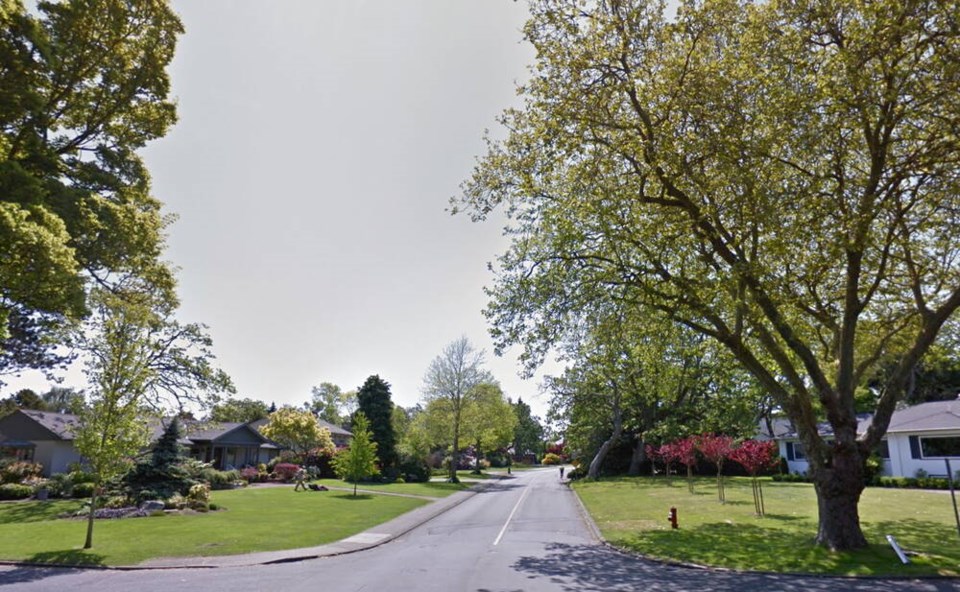A commentary by someone who lives on a block in Oak Bay where four construction projects are under way.
I have lived for many years near the Oak Bay/Victoria border.
While I’ve been here my neighbours have subdivided, razed, gutted, renovated, raised, rebuilt, enlarged, paved; they have also blasted, jackhammered, logged, bulldozed, landscaped, recontoured, dug deep.
In the course of all this improvement there is noise, dust, heavy traffic, explosions, huge vehicles struggling to manoeuvre in narrow lanes, parking problems, beeped warnings, flying rocks, all-clear horns, closed streets and repeated installations of underground facilities, blocked sidewalks, loss of greenspace and trees and habitat, and, of course, argument.
What there has never been is improved affordability, so it is a wonderful to learn from the expert guiding the provincial government’s plan to force some local governments to accelerate development and replace single family zoning with multiple dwellings that there is no intention to seek affordability, merely densification.
Tom Davidoff of UBC’s Sauder School of Business, who designed the method for assigning designated municipalities their quota of multiple dwellings, confirmed that: “We’re not going to see affordability. That’s not what’s on the menu here.”
What a relief: the goal is possible.
Oak Bay has seen a lot of construction (and destruction) in the way of improvement – but it is undoubtedly true this has mainly involved the same number of residents living in more gracious circumstances with increased amenities, albeit at the cost of peace, quiet and a lot of trees.
The provincial government wants more people to live in Oak Bay.
Densification will have the happy effects of raising the value of every owner’s piece of land and enriching everyone involved in designing and building the new structures while also increasing the number of taxpayers.
In return for zoning changes and quick permit approvals without the bother of public meetings the provincial government has promised not to punish Oak Bay for lazily acceding to the wishes of residents not bright enough (or too old) to understand how rapid change rewards everyone.
If residents stop clinging to the past and Oak Bay meets its quota some other place will be on Davidoff’s “naughty list.”
Oak Bay has experienced many years of the destruction of small houses to be replaced by large, and the hiving off of gardens to create new sites for large houses inhabited by one or two people.
The streets are clogged with heavy equipment and work vehicles as these changes are made and their upkeep ensured, so the most efficient way to comply with the provincial government’s quota would be to rezone larger properties to encompass multi-unit developments on single sites instead of encouraging piecemeal and often amateur and slow development of more laneway cottages or fourplexes on small lots: Bigger sites immediately available with room for townhouses and apartment buildings.
Instead of a hodgepodge of little projects that destroy trees and irritate everyone and take too long and overhouse one or two wealthy people, Oak Bay should think big and get apartment buildings built efficiently.
While either of our two lovely private golf courses would make admirable sites, what actually might work best is rezoning the Uplands.
Uplands includes many large lots that could provide adequate space for both multiple dwellings and parking and recreational amenities like pools and pickleball courts without undue disturbance to neighbours.
Some of the grand houses are certainly large enough for conversion into condominiums, a tactic proved successful in Rockland.
Recent work on sewers, drains and water mains will ensure capacity and densification will supply more taxpayers to help with costs.
Oak Bay could quickly meet the government quota for new development while providing current owners with significant incentives for cooperation by way of increased land value and at the same time protecting what remains of the tree canopy and gardens and peace in other less spacious corners of Oak Bay.
Uplands is so attractive that prices/taxes paid by new residents will maximize benefits to all concerned.
The UBC metric that assigns quotas requires that the most expensive land be used for densification, so clearly the Uplands is indicated.
Why not spread the wealth of densification a little further than shouting distance of city hall and include the elegant estates of the Uplands?
>>> To comment on this article, write a letter to the editor: [email protected]



